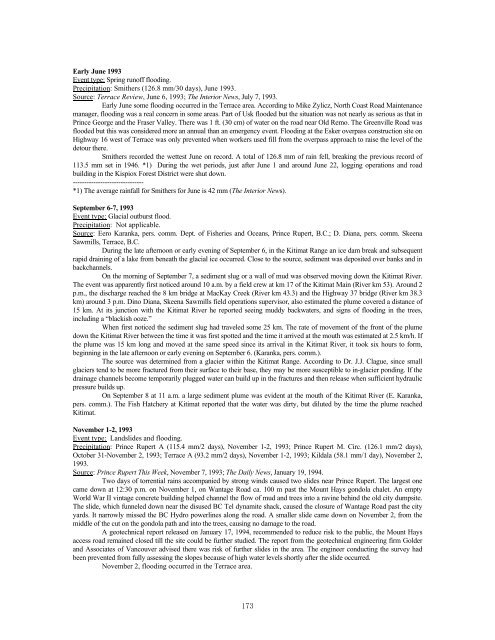HISTORICAL NEWS SEARCH - Government of British Columbia
HISTORICAL NEWS SEARCH - Government of British Columbia
HISTORICAL NEWS SEARCH - Government of British Columbia
You also want an ePaper? Increase the reach of your titles
YUMPU automatically turns print PDFs into web optimized ePapers that Google loves.
Early June 1993<br />
Event type: Spring run<strong>of</strong>f flooding.<br />
Precipitation: Smithers (126.8 mm/30 days), June 1993.<br />
Source: Terrace Review, June 6, 1993; The Interior News, July 7, 1993.<br />
Early June some flooding occurred in the Terrace area. According to Mike Zylicz, North Coast Road Maintenance<br />
manager, flooding was a real concern in some areas. Part <strong>of</strong> Usk flooded but the situation was not nearly as serious as that in<br />
Prince George and the Fraser Valley. There was 1 ft. (30 cm) <strong>of</strong> water on the road near Old Remo. The Greenville Road was<br />
flooded but this was considered more an annual than an emergency event. Flooding at the Esker overpass construction site on<br />
Highway 16 west <strong>of</strong> Terrace was only prevented when workers used fill from the overpass approach to raise the level <strong>of</strong> the<br />
detour there.<br />
Smithers recorded the wettest June on record. A total <strong>of</strong> 126.8 mm <strong>of</strong> rain fell, breaking the previous record <strong>of</strong><br />
113.5 mm set in 1946. *1) During the wet periods, just after June 1 and around June 22, logging operations and road<br />
building in the Kispiox Forest District were shut down.<br />
-------------------------------<br />
*1) The average rainfall for Smithers for June is 42 mm (The Interior News).<br />
September 6-7, 1993<br />
Event type: Glacial outburst flood.<br />
Precipitation: Not applicable.<br />
Source: Eero Karanka, pers. comm. Dept. <strong>of</strong> Fisheries and Oceans, Prince Rupert, B.C.; D. Diana, pers. comm. Skeena<br />
Sawmills, Terrace, B.C.<br />
During the late afternoon or early evening <strong>of</strong> September 6, in the Kitimat Range an ice dam break and subsequent<br />
rapid draining <strong>of</strong> a lake from beneath the glacial ice occurred. Close to the source, sediment was deposited over banks and in<br />
backchannels.<br />
On the morning <strong>of</strong> September 7, a sediment slug or a wall <strong>of</strong> mud was observed moving down the Kitimat River.<br />
The event was apparently first noticed around 10 a.m. by a field crew at km 17 <strong>of</strong> the Kitimat Main (River km 53). Around 2<br />
p.m., the discharge reached the 8 km bridge at MacKay Creek (River km 43.3) and the Highway 37 bridge (River km 38.3<br />
km) around 3 p.m. Dino Diana, Skeena Sawmills field operations supervisor, also estimated the plume covered a distance <strong>of</strong><br />
15 km. At its junction with the Kitimat River he reported seeing muddy backwaters, and signs <strong>of</strong> flooding in the trees,<br />
including a “blackish ooze.”<br />
When first noticed the sediment slug had traveled some 25 km. The rate <strong>of</strong> movement <strong>of</strong> the front <strong>of</strong> the plume<br />
down the Kitimat River between the time it was first spotted and the time it arrived at the mouth was estimated at 2.5 km/h. If<br />
the plume was 15 km long and moved at the same speed since its arrival in the Kitimat River, it took six hours to form,<br />
beginning in the late afternoon or early evening on September 6. (Karanka, pers. comm.).<br />
The source was determined from a glacier within the Kitimat Range. According to Dr. J.J. Clague, since small<br />
glaciers tend to be more fractured from their surface to their base, they may be more susceptible to in-glacier ponding. If the<br />
drainage channels become temporarily plugged water can build up in the fractures and then release when sufficient hydraulic<br />
pressure builds up.<br />
On September 8 at 11 a.m. a large sediment plume was evident at the mouth <strong>of</strong> the Kitimat River (E. Karanka,<br />
pers. comm.). The Fish Hatchery at Kitimat reported that the water was dirty, but diluted by the time the plume reached<br />
Kitimat.<br />
November 1-2, 1993<br />
Event type: Landslides and flooding.<br />
Precipitation: Prince Rupert A (115.4 mm/2 days), November 1-2, 1993; Prince Rupert M. Circ. (126.1 mm/2 days),<br />
October 31-November 2, 1993; Terrace A (93.2 mm/2 days), November 1-2, 1993; Kildala (58.1 mm/1 day), November 2,<br />
1993.<br />
Source: Prince Rupert This Week, November 7, 1993; The Daily News, January 19, 1994.<br />
Two days <strong>of</strong> torrential rains accompanied by strong winds caused two slides near Prince Rupert. The largest one<br />
came down at 12:30 p.m. on November 1, on Wantage Road ca. 100 m past the Mount Hays gondola chalet. An empty<br />
World War II vintage concrete building helped channel the flow <strong>of</strong> mud and trees into a ravine behind the old city dumpsite.<br />
The slide, which funneled down near the disused BC Tel dynamite shack, caused the closure <strong>of</strong> Wantage Road past the city<br />
yards. It narrowly missed the BC Hydro powerlines along the road. A smaller slide came down on November 2, from the<br />
middle <strong>of</strong> the cut on the gondola path and into the trees, causing no damage to the road.<br />
A geotechnical report released on January 17, 1994, recommended to reduce risk to the public, the Mount Hays<br />
access road remained closed till the site could be further studied. The report from the geotechnical engineering firm Golder<br />
and Associates <strong>of</strong> Vancouver advised there was risk <strong>of</strong> further slides in the area. The engineer conducting the survey had<br />
been prevented from fully assessing the slopes because <strong>of</strong> high water levels shortly after the slide occurred.<br />
November 2, flooding occurred in the Terrace area.<br />
173

















